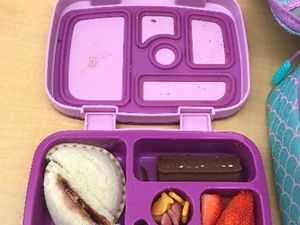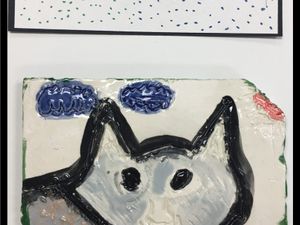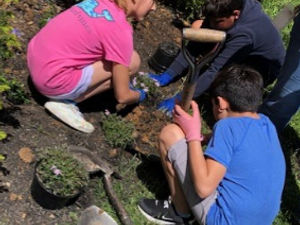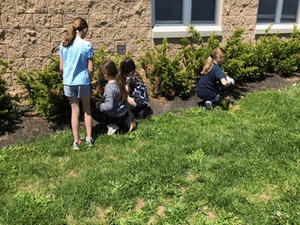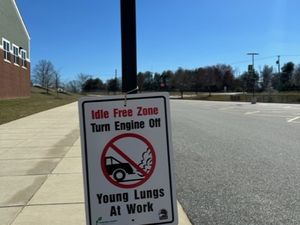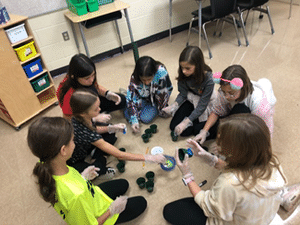Systemic Sustainability
Environmental Curriculum and Instruction
1.1 Curriculum and Instruction
Elementary & middle schools must provide one example of outdoor/environmental instruction per grade level.
High schools must provide one example of outdoor/environmental instruction in four subjects (which may include multiple different differents sciences).
During the 'Feature Article' writing unit, 85 fifth grade students researched the background on Maryland Green Schools, benefits of being a green school, ways to become a green school, and interviewed teachers in our school. They then wrote a feature article on why we should become a green school.
Padlet of green school resources and interviews the 5th grade students used to write their feature articles on becoming a green school.
Sharkey Feature Article (368.91 KB)
A fifth grade students feature article on becoming a green school.
During our Kindergarten Thematic Unit Block (TUB) students engage in lessons centering around how people impact our Earth and how Earth impacts its people. One lesson focuses on the importance of reducing, reusing, and recycling to help the Earth. Students were encouraged to go home and share ways they can help our Earth, many choosing to use reusable water bottles and lunch boxes at school to limit waste. Students then created posters sharing ways to save the Earth.
During science lessons on Oct. 12-14, 2022, twenty-four second grade students investigated how water flows from their school grounds into the rivers and streams and eventually into the Chesapeake Bay. Students gained the understanding that storm water runoff within the watershed will eventually flow into the Chesapeake Bay. Students used this knowledge to investigate whether water can transport trash from one place in the watershed to the rivers and streams and the bay. From their findings they made claims to explain how trash enters the Chesapeake Bay and made claims about the impact this has on humans, plants, and animals. Students determined that trash could enter the Bay through our drainage spots, so they created posters about pollution prevention to keep the Chesapeake Bay Clean.
2nd grade students investigated how water flows from their school grounds into the rivers and streams and eventually into the Chesapeake Bay.
2nd grade students investigated how water flows from their school grounds into the rivers and streams and eventually into the Chesapeake Bay.
2nd grade students investigated how water flows from their school grounds into the rivers and streams and eventually into the Chesapeake Bay.
2nd grade students investigated how water flows from their school grounds into the rivers and streams and eventually into the Chesapeake Bay.
2nd grade students investigated how water flows from their school grounds into the rivers and streams and eventually into the Chesapeake Bay.
2nd grade students investigated how water flows from their school grounds into the rivers and streams and eventually into the Chesapeake Bay.
2nd graders made claims to explain how trash enters the Chesapeake Bay and made claims about the impact this has on humans, plants, and animals.
2nd graders created posters about pollution prevention to keep the Chesapeake Bay Clean.
2nd graders created posters about pollution prevention to keep the Chesapeake Bay Clean.
The Grade 3 Life Science Unit focuses on how plants and animals grow and develop through similar life cycle stages, use inherited and acquired traits to survive on not survive given their environment and variations within species and how environmental changes impact organisms' ability to survive.
Students explored and investigated the life cycle of Painted Lady butterflies in order to observe and determine the 4 major phases of all life cycles (Birth, Growth/Development, Reproduction, Death). They were able to observe the caterpillars turn into chrysalis’ and then into butterflies! We made observations in our science notebooks at each stage of the life cycle.
During the 2021-2022 school year, three fourth grade classes studied endangered and invasive species in art class.
Students viewed artwork by contemporary artists who focus on endangered and invasive species in their artwork, such as Ithaca, NY based artist Jenny Pope.
Students then created relief clay tiles based on an endangered or invasive species of their choice. The sculptures were exhibited in a school showcase with student-made information cards.
4th grade endangered and invasive species art.
4th grade endangered and invasive species art.
4th grade endangered and invasive species art.
4th grade endangered and invasive species art.
4th grade endangered and invasive species art.
4th grade endangered and invasive species art.
4th grade endangered and invasive species art.
4th grade endangered and invasive species art.
4th grade endangered and invasive species art.
4th grade endangered and invasive species art.
4th grade endangered and invasive species art.
The children and I rummaged through the grade level recycling bin to get disposed papers we could use to stuff our centerpiece turkeys. We also used old, plastic cups that were discarded and leftover from the old science unit kits as bases for our turkeys. We used recycled construction paper to make the turkey’s faces.
The children took the turkeys home to place on their tables for Thanksgiving. They used them to start a discussion with their families about reducing waste and recycling and how our choices impact the health of our environment. (See next page for photos.)
More grade level lessons: Social Studies: Human Impacts on the Environment.
Sharing these turkeys with 180 first graders have inspired others to make environmentally friendly choices. First Grade teachers have reported that their students are making sure their lights are turned off when they leave their classrooms, that they bring in reusable lunchbags and waterbottles to use in school, and that they are recycling paper in their classroom recycling bins as well. Students use recycled paper during indoor recess art activities.
Students explored and investigated how pollination or the lack there of can have an effect on all plants and animals. Students research leads them through information on plant structures and animal structures that the survival of each is imperative. Once the investigation was complete the students grew butterflies in the classroom to assist with the pollination of neighboring flowers, which in turn, assisted the surrounding area plant growth and lead to more resources for the environment.
1.2 Green School Awareness
1.2.1 School Wide Awareness - Staff
Demonstrate that all school personnel are aware of your school's Green School status and application process.
Howard Eaks from Harford Glen came to our school and presented the Green School Program to the staff.
Howard Eaks from Harford Glen came to our school and presented the Green School Program to the staff.
Howard Eaks from Harford Glen came to our school and presented the Green School Program to the staff.
Howard Eaks from Harford Glen came to our school and presented the Green School Program to the staff.
Howard Eaks from Harford Glen came to our school and presented the Green School Program to the staff.
1.2.2 School-Wide Celebration
Demonstrate how your school celebrates beig a Green School by hosting a school-wide environmentally-focused event open to all students.
All 1,123 students will participate in Earth Day this year on Friday, April 21, 2023. Each grade level will focus on Earth Day topics in each subject.
All 1,123 students will participate in Earth Day this year on Friday, April 21, 2023. Each grade level will focus on Earth Day topics in each subject. Each grade level submitted an outline of what they will teach on Earth Day.
Environmental Professional Development for Teachers
1.3.1 Environmental Professional Development for Teachers
Demonstrate that 10% of staff have completed an environmental PD. Instructional staff is defined as any staff that manages a gradebook.
- New Schools must have all PD completed within the past 2 academic years.
- Renewing schools must have all PD completed within the past 4 academic years.
A teacher who has participated in multiple workshops may only be counted once..
A representative from The Harford County Bird Club came to the school to teach the 5th grade teachers how to lead our class on a bird walk around the school campus and become young birders. She gave brought binoculars and trained us on how to use them and how to log the birds we see.
A representative from The Harford County Bird Club taught the 5th grade teachers how to lead our class on a bird walk around the school campus and become young birders. She brought binoculars and trained us on how to use them.
Information from The Harford County Bird Club showing what they educated the teachers about so we can teach the students about being young birders.
Email from the Education Coordinator at The Harford County Bird Club confirming our meeting to learn about teaching our students to become young birders and the bird walk on Earth Day.
A representative from The Harford County Bird Club taught the 5th grade teachers how to lead our class on a bird walk around the school campus and become young birders. She brought binoculars and trained us on how to use them.
A representative from The Harford County Bird Club taught the 5th grade teachers how to lead our class on a bird walk around the school campus and become young birders. She brought binoculars and trained us on how to use them.
A representative from The Harford County Bird Club taught the 5th grade teachers how to lead our class on a bird walk around the school campus and become young birders. She brought binoculars and trained us on how to use them.
A representative from The Harford County Bird Club taught the 5th grade teachers how to lead our class on a bird walk around the school campus and become young birders. She brought binoculars and trained us on how to use them.
A representative from The Harford County Bird Club taught the 5th grade teachers how to lead our class on a bird walk around the school campus and become young birders. She brought binoculars and trained us on how to use them.
A representative from The Harford County Bird Club taught the 5th grade teachers how to lead our class on a bird walk around the school campus and become young birders. She brought binoculars and trained us on how to use them.
A representative from The Harford County Bird Club taught the 5th grade teachers how to lead our class on a bird walk around the school campus and become young birders. She brought binoculars and trained us on how to use them.
1.4 Achieving Sustainable Schools
1.4.1 School-Wide Staff Sustainability
Demonstrate the sustainability practices your teachers, staff, and other personnel have implemented school-wide to make your school green. Any actions involving students belong under Objective 2.
We post our monthly newsletters on the school website instead of sending paper copies home. We copy front to back, and we shrink the size so we can get more copies on one page reducing the amount of copies we need. We also email communications home to parents instead of sending copies.
1.4.2 Systemic Partnership
Demonstrate one partnership with a central office or board within the school system that supports part of the Maryland Green Schools Program. Any partnerships outside of your school system belong under Objective 3.
The Harford Glen Environmental Education Center, an integral part of the Harford County Public School System, coordinates a comprehensive, sequential, and participatory program of environmental education. By focusing on a curriculum that promotes awareness, and understanding of the local and global environment, the Harford Glen staff seeks to produce a responsibility ethic of stewardship and sustainability in the total school community. Every year the 2nd graders take a field trip there and the 5th graders stay overnight 2 nights.
5th grade students at Harford Glen cutting invasive species.
5th grade students at Harford Glen cutting invasive species.
5th grade students at Harford Glen cutting invasive species.
5th grade students at Harford Glen cutting invasive species.
5th grade students at Harford Glen cutting invasive species.
Student Action
Schools must document eight total actions that address at least three of the listed sustainability practices.
These are student actions not adult actions. Adult sustainable actions can be documented in Objective 1.4.
2.1 Water Conservation/Pollution Prevention
2.1 Water Conservation/Pollution Prevention
No records were added by the school.
2.2 Energy Conservation
2.2 Energy Conservation
Eighty five 5th graders and 21 second graders and made signs to hang around the school. They each took a category to help our school be more environmentally friendly. The posters were hung around the school for all grades to see. Fifth graders made posters to remind teachers to turn their smart boards off when not in use and second graders made posters reminding teachers and students to turn lights off.
Students creating energy conservation posters.
Students creating energy conservation posters.
Students creating energy conservation posters.
Students creating energy conservation posters.
Students creating energy conservation posters.
Students creating energy conservation posters.
Students creating energy conservation posters.
Students creating energy conservation posters.
2.3 Solid Waste Reduction
2.3 Solid Waste Reduction
Seventy second grader students begin a reusable water bottle campaign to encourage others to use water fountains and reusable water bottles instead of store-bought plastic bottles whenever possible. • Reminders in Homework pads and emails. • Students holding their reusable bottles
Terracycle is a recycling program which takes various products and turns them into new products such as tote bags, t-shirts, and stuffed animals. Our students are taking part in several brigades such as Lil Bites, Health care products and toothcare products.
2.4 Habitat Restoration
2.4 Habitat Restoration
5th grade students learned about the importance of having native pollinator gardens. They selected native pollinators and figured out how many plants were needed to plant outside the 5th grade. On May 10, 2022 the same students planted to flowers. They planted phlox and butterfly weed. The same 5th grade students made a sign explaining what flowers were in the garden and monitored the garden throughout the summer.
Twenty-seven fifth grade students assessed the mulch and beds with bushes around the school. It was discovered that the mulch was too thick and the trees were in distress. There were also many weeds and dead branches on the bushes. The students spread the mulch to a thinner level, pulled weeds, and trimmed the dead branches.
5th graders learned about biodiversity and the importance of having native pollinator gardens. They partnered up and planted native pollinator seeds in milk jugs that will grow over winter in our outdoor atrium. In the spring they will be transferred to our raised bed gardens.
2.5 Opportunities for Nature Exploration
2.5 Opportunities for Nature Exploration
Students read and complete assignments outside WHENEVER the weather is nice. Students bring in towels and blankets to sit on or just sit on the ground. Outdoor seating is also used.
2.6 Responsible Transportation
2.6 Responsible Transportation
We are promoting responsible transportation by hanging 'Idle Free Zone' signs in the car rider line so parents can see. YBES does not have any sidewalks leading up to it and we are located on a busy road, therefore we aren't allowed to have any walkers or bike riders. We only have bus riders. All students are assigned a bus, however, parents pick students up and wait in a car rider line.
2.7 Healthy Indoor Environments
2.7 Healthy Indoor Environments
A group of 5th graders learned about grow rooms and the variety of lettuces and herbs to grow. They planted the seeds and labeled each plant to correspond with what is growing. Once the plants were harvested the students donated the greens to the cafeteria to use in salads for the students.
2.8 Citzen/Community/Participatory Science
2.8 Citizen/Community/Participatory Science
No records were added by the school.
Community Partnership
Demonstrate that your school is forming long-term partnerships to foster environmental stewardship and cultivate community wellness through real-world connections.
3.1 Community Partnerships
3.1.1 School Active in Community
Describe at least one environmentally-focused partnership in which your school is working to benefit your community.
Last year our vice president, Tyme suggested that our school should help save the birds by adding window decals. The point was, because birds kept flying into windows. But Tyme brought this up around the end of the year and that didn’t give the school enough time to put this project together. The decision was made to bring his idea back this year. Here is the procedure we have followed: All you need are suction cups with hooks, string, index cards, and clothespins.
First, put one suction cup with the hook facing up at the top of the window.
Put a second suction cup with the hook facing down on the bottom of the window.
Then, thread the string through both suction cup hooks, tying a loop at the end.
Next, clip the clothespins equally on the string. Then, you can slide the index card under one side of the clothespin, so it stays on the string... Also, if you decide to put this up in the library, you can put book recommendations on the index cards. Anywhere else, you can draw something on the index cards.
-
We have eight garden beds on the school campus that we maintain. They contain a mix of native perennials, vegetables, and annual flowers to attract pollinators and deter pests.
-
We maintain 16 bluebird houses on campus and are hoping to install more with the scouts. This includes cleaning them annually, removing sparrow nests, and recording clutches of eggs.
-
On Earth Day 2022 we did a campus wide trash clean up
-
We have gotten the PTA to transition away from single use plastic water bottles at events. From now on students will be asked to bring their own bottle (as they do in school) to all after-school PTA events. We will also have large water jugs with compostable paper cups for those that forgot/do not use a water bottle in school.
3.1.2 Community Active in the School
Describe at least one partnership in which a community partner is benefitting the school. These actions and projects occur on or near school grounds with support from the partner.
The fifth grade partnered with BGE to implement the Smart Energy Program. BGE's Smart Energy Academy is a program that partners with local elementary schools to provide fun interactive lessons and hands-on learning kits that power students to be smart energy savers! Lumi, BGE’s virtual energy coach, is here to help students actively learn about the exciting world of electricity and ways to save energy and money. Each student took a kit home with energy efficient faucets, shower head, LED light bulbs and a testing kit to test the water pressure at their house and the temperature of the water in their hot water heater. The students and their parents signed a contract stating they would implement items in the kit in their homes to make their homes more energy efficient.
3.2 Additional Achievements
3.2 Additional Achievements optional
Share any environmentally-related awards, special recognition, certifications, or other achievements that your school, staff or students have accomplished.
No records were added by the school.

